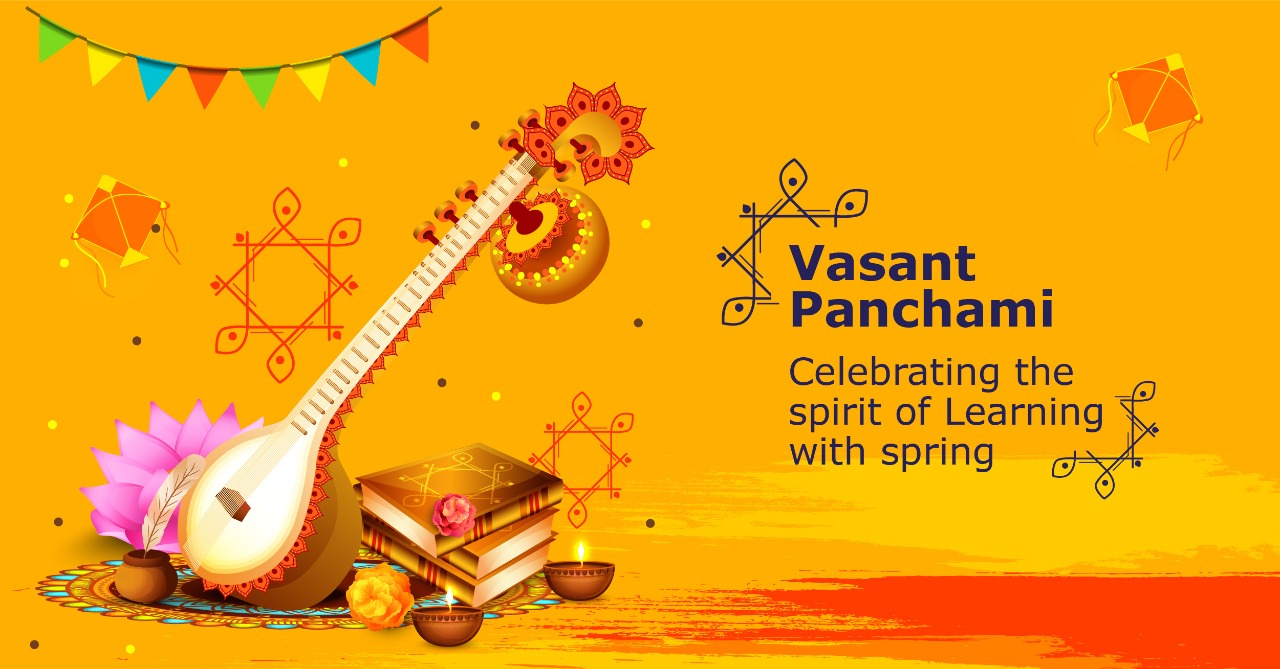VASANT PANCHAMI: CELEBRATING THE SPIRIT OF LEARNING WITH SPRING
 Posted On
Posted On
755 total views, 1 views today
Our Mother Earth is in constant motion. She is wheeling around, at her own pace and time and it’s in this wheeling that “we”, her children get rhythm of life. Yes, with Earth’s movements, we experience the phenomenon of day and night and the annual change of seasons. Earth’s motion or movements are broadly of two types: Rotation, wherein she spins around her axis in 24 hours and by virtue of which we observe day and night; Another is the annual movement of the Earth around the Sun, known as Revolution, where she revolves around her orbit centring the Sun and this annual movement of her creates the “rhythm of seasons”.
In this “rhythm of seasons” , the last to arrive in full bloom is “Spring”. Spring marks the arrival of joy, abundance, happiness, which are symbolized with the spirit of new life, wisdom and learning. Hence , in India Vasant or Basant Panchami is celebrated to mark the arrival of Spring season, associated with the worship and blessings of the Goddess of Learning : Saraswati. This festival of harmony signifies that Spring, “the King of seasons” has ushered in full bloom, with enrichment of harvest all over.
Let’s now take a quick sneak-peak into some of the interesting facts related to the festival
• It is celebrated on the fifth day of the bright half of the “Magha” lunar month and marks the onset of Spring
• Basant Panchami is popularly celebrated as “Saraswati Puja” in most parts of the country and especially in the Eastern states of West Bengal, Assam, Tripura, Bihar etc, across castes and communities. Goddess Saraswati . Goddess Saraswati is the Goddess of learning, education, music, aesthetics , language and all forms of arts. She symbolizes creative energy and power in all its form, including longing and love. Many families mark this day by sitting with babies and young children, encouraging their children to write their first words with their fingers, and some study or create music together. Indians usually dress up in yellow this day, associated with the Goddess’s favorite colour as well as the ripening of the mustard fields. Many educational institutions arrange special prayers or pujas in the morning to seek the blessing of the goddess. Poetic and musical gatherings are held in some communities in reverence for Saraswati. Usually, toddlers start learning from this day in a unique ceremony named ‘Khadi-Chuan’/Vidya-Arambha. Students, musicians and artists pray their homage to the Goddess, irrespective of caste, community, religion and any discrimination, marking the spirit of the festival truly a symbol of harmony!
• In the Punjab region, it’s celebrated as Basant Festival of Kites, a seasonal festival observed by all faiths. The shrine of the Sun-God known as Deo Sun Shrine at Aurangabad district of Bihar is worshipped on this auspicious day. Lord Kamdeva is too worshipped on this day.
• In many parts of South India, the festival is known as Shri Panchami
• Celebrations are also marked in Golden Temple of Amritsar and at Nizamuddin Dargah of Delhi.
• Basant Panchami also marks the start of preparation for Holika or Holi, which ushers 40 days later.
• Renowned educationist Madan Mohan Malaviya established Banaras Hindu University or BHU in 1916 on this day of Basant Panchami.
• The traditional yellow rice is cooked on this day. Basant Panchami is associated with the yellow mustard fields, revealing the blossoming of Mother nature and her abundance on earth.
“Vasanta is one of my many forms” : Lord Krishna once said (Bhagwad Geeta) ..Truly Mother Nature and her spiritual embodiment is best reflected in the flavor of seasons. Hence, let’s embrace the spirit of the festival, reflected in the synthesis and harmony of all and pray that the Divine blessings uplift our minds onto the paths of true learning!



